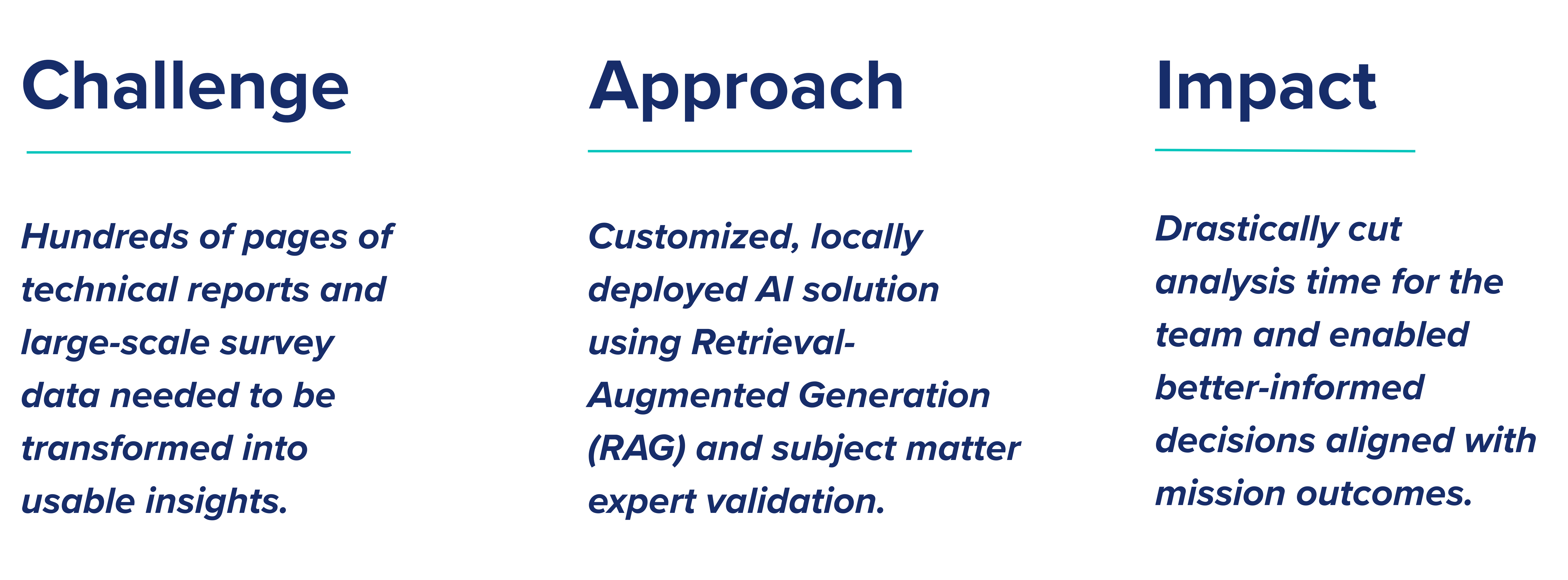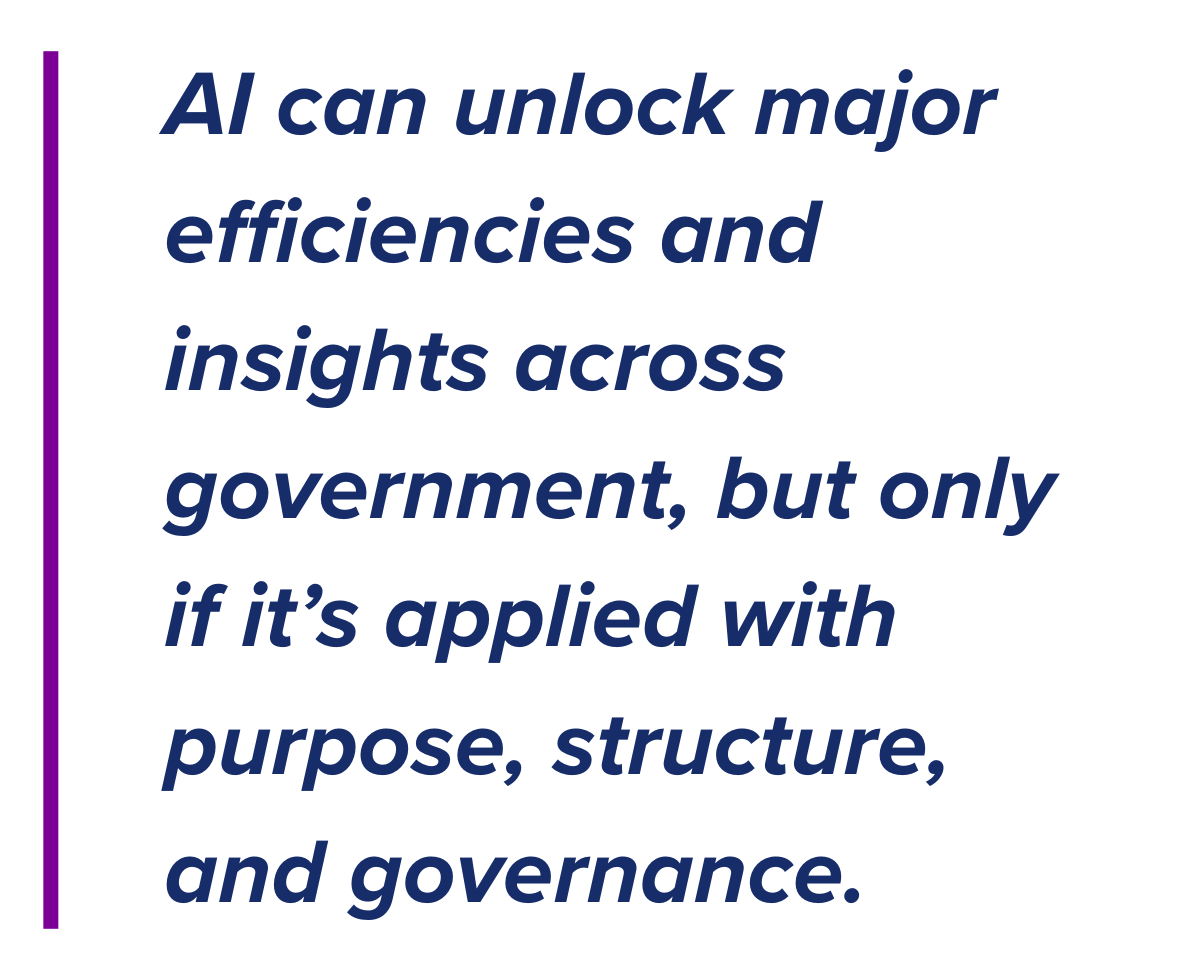Blog and News
Beyond the Hype: Delivering AI Solutions That Advance Federal Missions
Artificial Intelligence (AI) is evolving fast, but implementation in federal agencies is still lagging. The real challenge isn’t building chatbots or testing tools. It’s applying AI solutions in ways that are secure, scalable, and aligned with your mission.
The America’s AI Action Plan reinforces this urgency, calling on agencies to accelerate adoption while maintaining trust, security, and measurable impact. But meeting that mandate demands execution.
To build and apply AI effectively, start with a clear understanding of the problem you're solving. This could be cutting report backlog, improving citizen services, or speeding up policy analysis. With that goal in place, you can shape your use case intentionally.
Bixal’s Proven Approach to AI Implementation
When a federal food security initiative faced hundreds of pages of dense technical reports and large survey datasets, Bixal helped reduce report preparation time, cut manual review time, and accelerate data analysis. By automating routine tasks, we freed up staff to focus on policy development, stakeholder collaboration, and mission-critical decisions.

Here’s how we made it work:
Choosing the right technology:
We deployed an open-source large language model locally, ensuring data security while reducing development costs compared to commercial APIs, with accuracy that rivaled larger platforms. For agencies needing enterprise platforms, we guide them to FedRAMP-compliant tools that fit seamlessly within their IT environment.
Partnering with subject matter experts (SME):
From day one, we embedded agricultural and policy experts to guide prompt design and review outputs. This ensured AI-generated summaries aligned with mission priorities and field realities, making insights actionable for teams.
Using RAG:
To process lengthy reports and complex datasets, we implemented RAG pipelines that quickly retrieved the most relevant information, enabling staff to query large surveys and receive clear, source-cited answers within seconds.
Piloting and iterating:
We launched small pilots with clear goals, such as summarizing reports with 80% accuracy, and iterated in focused sprints to refine results. This allowed the agency to see measurable impacts quickly and adapt without waiting for lengthy rollouts.
Ensuring responsible AI:
We integrated bias testing, audit trails, and transparency features from the start, aligning outputs with federal ethical AI policies while minimizing security risks through local processing.

Five Challenges to Address Before You Deploy AI
To move beyond experimentation and ensure AI solutions provide mission-focused results, agencies should address these five challenges:
1. Define a Mission-Focused Use Case
Pinpoint a clear, high-priority problem AI can solve, such as reducing analysis backlogs or accelerating case review, rather than adopting AI for its own sake. Involve SMEs early to ensure the use case targets real needs and delivers measurable outcomes.
2. Ensure Data Readiness
AI depends on high-quality data. Audit your data for gaps and inconsistencies, and clean and organize it using tools like Optical Character Recognition and Extract, Transform, Load pipelines. Preparing data upfront avoids delays and ensures reliable outputs.
3. Establish Governance and Risk Management
Assign leadership and form a cross-functional oversight team to guide AI strategy, manage risks, and align efforts with federal policy and Office of Management and Budget guidance. Establish frameworks for bias testing and continuous monitoring to maintain responsible practices.
4. Prepare Your Workforce
Equip staff to work confidently with AI by providing training and change management support. Involve SMEs in development and validation to ensure outputs remain relevant and accurate while fostering a culture that sees AI as a mission accelerator.
5. Design for Integration and Scalability
Plan AI pilots that align with your IT environment and have a clear pathway to scale. Ensure your infrastructure can support expanding use cases, avoid one-off experiments, and ensure your AI investments deliver sustained value.
From Exploration to Execution: Making AI Solutions Work for Your Mission

AI can unlock major efficiencies and insights across government, but only if it’s applied with purpose, structure, and governance.
Moving from exploration to execution takes more than tools. It requires mission alignment, strong data foundations, and a partner who understands the federal environment.
Where to start:
- Gather stakeholders to identify a high-impact problem AI can solve to advance your agency’s mission.
- Audit and prepare your data sources for AI readiness. Clean, accessible, and structured content is the foundation of effective AI.
- Define governance roles, processes, and set clear performance indicators from the outset.
Ready to move beyond experimentation and deliver AI solutions that make a difference? Contact us by submitting the form below to learn how our tailored, responsible approach helps federal agencies harness the power of AI in ways that are practical, measurable, and built to last.